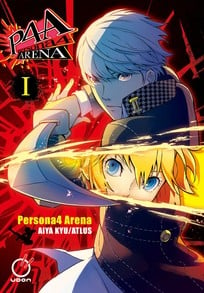Review
by Richard Eisenbeis,Persona 4 Arena GN 1-3
| Synopsis: |  |
||
When terrorists hijack an airplane to steal an anti-shadow android named Labrys from the Kirijo Group, Persona 3's Mitsuru, Aigis, and Akihiko track the culprit to the countryside town of Inaba and head there to take Labrys back. Meanwhile, taking advantage of the Golden Week holidays, Persona 4's Yu Narukami heads to Inaba to spend his time with his friends and family. However, upon his arrival, he finds that not only have some of his friends mysteriously disappeared but that the Midnight Channel has started once more—and now it is advertising a fighting tournament between him and his friends. Worried about what this might mean, Yu and his remaining friends head into the TV world to solve the mystery. |
|||
| Review: | |||
Persona 4 Arena is based on the 2012 fighting game of the same name. However, it's simply not possible to do a one-to-one adaptation of that game. Instead of having a single, unified story, the game's story is different based on whichever character you're playing. Because of this, there are 12 different versions of the story to choose from. While it would seem logical to draw from Yu's story most heavily (as he is the main character of Persona 4), the manga instead gives the main hero role to Yosuke. In the original Persona 4, Yosuke most often acts as the sidekick/comic relief character—and while part of his arc in Persona 4 was him overcoming this, deeply rooted insecurities don't go away so easily. Throughout the manga, he is forced to re-confront these ideas—to figure out if he has really changed or not—and in the process step out of Yu's shadow and become an independent hero all his own. Part of what helps Yosuke grow is his interactions with Labrys and his need to save her—fearing she is yet another helpless victim thrown into the TV world like those seen in Persona 4. However, the Labrys that Yosuke befriends isn't robotic in either personality or physical appearance. Labrys is supposed to be a model of an android even older than Aigis—yet, the Labrys in the story is anything but. Why she is this way forms one of the main mysteries of the manga—along with who stole Labrys in the first place and who the mastermind behind the tournament truly is. One of the other big selling points of this manga is that, while this story is called “Persona 4 Arena,” this manga is a direct sequel to both Persona 3 and Persona 4—taking place two years after the events of Persona 3 and a month after the events of Persona 4. This means a good chunk of the story deals with seeing how the Persona 3 characters have grown in the time since the game ended. Mitsuru, Aigis, and Akihiko are committed to protecting the world from the shadows and righting the wrongs of the Kirijo group. Mitsuru and Aigis especially have rather solid character arcs. Mitsuru is dealing with the crushing responsibility of her family's name and associated sins. While she's holding up well thanks to her friends' support, she longs for an excuse to just let loose and fight—to stop thinking of the future and just live in the moment. As for Aigis, she is dealing with the idea that she has a family—an older sister desperately in need of her help. Moreover, like Yosuke, past insecurities (namely those about not being human) are brought back to the forefront by the battles within the TV world. All in all, the Persona 4 Arena manga is a decent adaptation of the video game that is willing to take chances on what it chooses to adapt and what it doesn't to create a story that subverts expectations—especially for those who have played the original game. The only real weak point is the art—because while it does a good job at selling the story's darkest and most brutal moments, the general lack of backgrounds gives the whole story a strangely sterile feel which hurts the manga overall. Still, if you're a Persona fan and fighting games aren't your thing, this manga is a great way to experience the continuing story of your favorite Persona 3 and Persona 4 characters. |
| Grade: | |||
|
Overall : B-
Story : B
Art : C-
+ The continuing adventures of the heroes of both Persona 3 and Persona 4 in an adaptation that isn't afraid to go it's own way. |
|||
| discuss this in the forum (1 post) | | |||
| Production Info: | ||
|
Full encyclopedia details about |
||